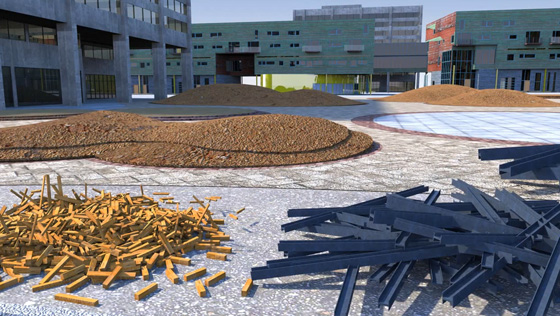美조경가협회 ‘폐건자재로 공원조성’
미국 조경계 화두 ’지속가능한 조경’

지속가능한 조경을 영위하기 위한 하나의 수단으로서, 건물을 헐고 발생한 건설자재를 신규 공원 조성에 활용하자는 주장이 미조경가협회를 통해 발표되었다.
지난 2일 미조경가협회(ASLA)는 단체에서 운영하는 블로그 'Dirt'에 'Build
ing a Park Out of Waste'라는 제목의 글에서 이같이 밝혔다.
그동안 미조경가협회는 지속가능한 조경(Designing Our Future: Sustaina
ble Landscapes)이란 테마아래 기후변화와 탄소배출 저감에 대한 조경적 접근을 시도하는 한편, 지속가능한 조경을 수행했던 대표 프로젝트 20개의 사례를 발굴하여 홈페이지에 게시하기도 했다.(관련내용 보기)
블로그에 게재된 애니메이션에서는 이러한 지속가능한 조경이란 흐름 속에서 어떻게 폐건축자재를 재활용해 아름다운 공원으로 조성할 것인지 보여주고 있다.
Building a Park Out of Waste from ASLA on Vimeo.
ASLA는 건물을 헐고 남은 건축자재의 이용을 통해 자원이용을 최대화하고, 온실가스 방출은 최소화 할 수 있다고 하였다.
건물을 새로 짓게 되면, 방대한 양의 자원에너지가 소요되는데, 그러한 빌딩건설에 드는 자원은 전세계 온실가스 방출량의 5.5%를 차지한다고 한다.(Architecture 2030 인용) 게다가 건설을 위한 자재설치, 트럭과 크레인 운송도 온실가스 방출을 늘리는 요소로 작용하기 때문에 이 역시 정확한 수치가 아니라는게 협회의 설명이다.
그동안 건축물을 허물 때 나오는 폐기물들은 쓰레기 매립지로 버려져 왔다. 미국 환경보호단체는 건설폐기물의 40%만이 현재 재활용, 재이용되거나 폐기물 에너지화 시설로 보내진다고 밝혔다.
지속가능한 흐름에 발맞추어 미국의 많은 조경가와 건축가, 그리고 건설사들은 현재 쓰레기 감축과 온실가스 방출을 줄이기 위한 건설 프로세스 변화에 박차를 가하고 있다.
이러한 노력 중 하나가 바로 건축자재의 복원을 통한 지속가능한 자재의 재사용이다. 상단의 애니메이션처럼 폐기될 건자재를 통해 신규 공원도 만들 수 있다. 건축물 신축공사에 소요된 매립토, 콘크리트 파편, 유리, 나무, 그리고 철은 공원을 조성하는 새로운 자재로 재활용해 사용할 수 있는 것이다.
미조경가협회는 "새로운 건설방법을 통해 조경가는 온실가스의 추가적인 배출을 줄이는데 일조할 수 있다. 결국 새로운 건설방법을 통한 건자재의 재사용은 온실가스 배출을 줄이게 됨으로써 사회전체에 이익을 가져오게 될 것이다. 지속가능한 조경에서 모든 오래된 것들은 새로운 것으로 다시 만들 수 있다."고 밝혔다.
<원문>
Building a Park Out of Waste
Watch an animation from ASLA’s “Designing Our Future: Sustainable Landscapes” online exhibition that explains how to reuse building demolition waste to create a beautiful new park. Learn how to maximize available resources and lower greenhouse gas emissions:
Traditional ways of constructing buildings create pollution and waste. Building materials contain vast amounts of embedded energy. According to Architecture 2030, building construction and materials account for 5.5 percent of global greenhouse gas emissions. In addition, while exact numbers aren’t available, trucks and cranes transporting and installing materials at construction sites produce considerable amounts of greenhouse gas emissions.
(Source: Architecture 2030)
Typically, materials from torn-down buildings and sites are carted off to the landfill. The U.S. Environmental Protection Agency says only 40 percent of building and construction material is now “recycled, reused, or sent to waste-to-energy facilities, while the remaining 60 percent of the materials is sent to landfills.” Many sustainable architects, landscape architects, and construction firms are now moving towards a more sustainable construction process to reduce waste and greenhouse gas emissions. (Source: Environmental Protection Agency)
In a sustainable reconstruction, building materials are reused or recycled, dramatically reducing waste. For example, a new park can be created out of old building materials. Once the materials have been separated, some are kept at the construction site and reprocessed. Reclaimed soils, concrete rubble, glass, wood, and steel can be reused or recycled to serve new functions, reducing greenhouse gas emissions in the process. With climate change, any new construction methods that help landscape architects avoid producing additional emissions are a major benefit both to the project and society as a whole. In a sustainable landscape, everything old is made new again. (Source: Reuse Alliance)
출처: ASLA ‘The Dirt’